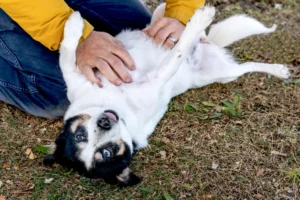
Due to a famous Pixar film, we now all refer to Elizabethan collars for dogs by another name – “cone of shame”.
Dog cones of shame is an incorrect description, however. Contrary to Dug’s evil master in Up, real-world cones serve an invaluable purpose: protecting wounds from being nibbled at or licked to speed healing time.
Although humans appreciate that, most dogs don’t. It limits their playtime and makes eating and drinking harder for them. Speak with your veterinarian about an alternative solution–perhaps a doughnut-style collar–if he or she feels that this still provides sufficient protection.
Roy Wilson, DVM and Regional Medical Director for VCA Animal Hospitals provided us with all the information we needed about cone of shame collars.
What Are E-Collars for Dogs? E-collars are short for Elizabethan collars – similar to what humans wore back in 16th Century Europe. They serve the same purpose.
Wilson says cones serve a similar function for dogs after suffering wounds from spay and neuter procedures, or having stitches left from surgery (including spay and neuter procedures ). Dogs tend to develop the “natural instinct” to chew or lick at any wound they sustain, which Wilson warns can delay healing, allow bacteria into their system, or in extreme cases cause them to try eating parts of themselves!
Wilson advises that, to keep your pup on the mend and prevent further medical visits, a cone (and sometimes pain and anti-anxiety medication) are often required for recovery.
Be warned: the large plastic cone offers the most effective method for helping your dog heal quickly. Just work closely with your veterinarian to make sure it fits correctly and your pup feels secure wearing it.
Wilson believes it can cause anxiety in some pets and inconvenience for both pet and caretaker, with rare instances involving skin lesions on the neck as being harmful.
Preparing Your Dog for a Cone
If you anticipate that your pup will require a cone soon, there are a few things you can do ahead of time to make both of your lives simpler:
Introduce them to their cone gradually. As with boots, this means letting them sniff and investigate it first before placing it over their heads.
Rehearsal Sessions. Give the dog treats every time they wear the cone so that he or she associates this headwear with something delicious, creating a powerful association between it and something delicious!
Distract them. Once your dog has his cone on, give him something else to occupy his time – like food puzzles or interactive toys – so he forgets he has the cone on.
Give them enough room to move. A cone on their heads won’t help them see well, so eliminate any obstacles in their path (including breakable objects you treasure).
Wilson recommends other alternatives for protecting recovering dogs from themselves than the cone, depending on the dog and injury they’re recovering from, Wilson says.
These inflatable doughnut collars make your dog appear like they’re using it as a neck pillow during an overnight trans-Atlantic flight.
Wilson notes that these collars may still be cumbersome for your dog to use, but at least it allows him to see everything around him and still eat and drink freely. Wilson cautions that some animals might find ways to get around it to access wounds of their own.
Inflatable Cones
Similar to an inflatable collar, inflatable cones provide the same feel but with added cushion. Wilson notes they may still allow some dogs around it but will be less disruptive on your coffee table should one come crashing down!
Shirts and Socks
Maybe your dog doesn’t require a cone or collar at all; in these instances putting on T-shirts or socks may suffice in covering their incision and making life easier on all involved.
Wilson warns against giving clothing as gifts as it may irritate incisions and rashes and allow moisture to collect on their skin, potentially leading to further skin issues.
Dogs use their mouths to try to use clothing as an extension of themselves to try to nibble or lick at their wounds through it. Clothing alone may not be best for all dogs as some could ingestion socks or clothing pieces and become at risk for GI foreign bodies which require surgery to fix.
Alternative Solutions
A 2020 survey from University of Sydney researchers demonstrated how cones affected pets’ ability to eat and drink regularly, play actively, navigate their home safely and navigate freely – some even removed their collars by themselves!
Researchers suggest inflatable collars and clothing as possible alternatives, along with visors, muzzles, and neck restraints as alternatives to cones in certain circumstances. When combined with anti-itch medication, painkillers or topical anesthetics/sedatives they could potentially serve as viable replacements.
Yustina Shenoda, an undergraduate veterinary student who conducted this survey and advised it’s lead investigator, noted that veterinarians must inform clients on what potential discomfort their pets could experience while wearing the cone.
“At a minimum, we suggest giving owners tips to assist their animals with drinking and eating as well as encouraging them to monitor them while wearing collars,” Shenoda advised in a news release.
Talk with your veterinarian. If your concerns about the cone of shame extend to your dog, work together with them to identify suitable alternatives. Keep in mind that hard plastic cones provide more protection than many alternatives and could be an appropriate choice in certain instances; weigh inconvenience against longer healing times, risks associated with repeat surgeries/procedures and possible additional medical costs should your pet access its wound/incision leading to additional injuries in comparison. Get input from your vet prior to purchasing an alternative before making your purchase decision, or invest time getting your pet used to wearing one before purchasing one – making a change can make all the difference for everyone involved!





